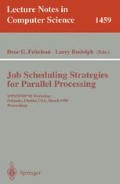Abstract
The evaluation of parallel job schedulers hinges on two things: the use of appropriate metrics, and the use of appropriate workloads on which the scheduler can operate. We argue that the focus should be on on-line open systems, and propose that a standard workload should be used as a benchmark for schedulers. This benchmark will specify distributions of parallelism and runtime, as found by analyzing accounting traces, and also internal structures that create different speedup and synchronization characteristics. As for metrics, we present some problems with slowdown and bounded slowdown that have been proposed recently.
Preview
Unable to display preview. Download preview PDF.
References
M. Calzarossa, G. Haring, G. Kotsis, A. Merlo, and D. Tessera, “A hierarchical approach to workload characterization for parallel systems” In High-Performance Computing and Networking, pp. 102–109, Springer-Verlag, May 1995. Lect. Notes Comput. Sci. vol. 919.
M. Calzarossa and G. Serazzi, “A characterization of the variation in time of workload arrival patterns” IEEE Trans. Comput. C-34(2), pp. 156–162, Feb 1985.
M. Calzarossa and G. Serazzi, “Workload characterization: a survey” Proc. IEEE 81(8), pp. 1136–1150, Aug 1993.
S-H. Chiang and M. K. Vernon, “Dynamic vs. static quantum-based parallel processor allocation” In Job Scheduling Strategies for Parallel Processing, D. G. Feitelson and L. Rudolph (eds.), pp. 200–223, Springer-Verlag, 1996. Lect. Notes Comput. Sci. vol. 1162.
A. B. Downey, “A parallel workload model and its implications for processor allocation” In 6th Intl. Symp. High Performance Distributed Comput, Aug 1997.
A. B. Downey, “Predicting queue times on space-sharing parallel computers” In 11th Intl. Parallel Processing Symp., pp. 209–218, Apr 1997.
M. Drozdowski, “Scheduling multiprocessor tasks — an overview” European J. Operational Research 94, pp. 215–230, 1996.
D. G. Feitelson, “Packing schemes for gang scheduling” In Job Scheduling Strategies for Parallel Processing, D. G. Feitelson and L. Rudolph (eds.), pp. 89–110, Springer-Verlag, 1996. Lect. Notes Comput. Sci. vol. 1162.
D. G. Feitelson and M. A. Jette, “Improved utilization and responsiveness with gang scheduling” In Job Scheduling Strategies for Parallel Processing, D. G. Feitelson and L. Rudolph (eds.), pp. 238–261, Springer Verlag, 1997. Lect. Notes Comput. Sci. vol. 1291.
D. G. Feitelson and B. Nitzberg, “Job characteristics of a production parallel scientific workload on the NASA Ames iPSC/860” In Job Scheduling Strategies for Parallel Processing, D. G. Feitelson and L. Rudolph (eds.), pp. 337–360, Springer-Verlag, 1995. Lect. Notes Comput. Sci. vol. 949.
D. G. Feitelson and L. Rudolph, “Toward convergence in job schedulers for parallel supercomputers” In Job Scheduling Strategies for Parallel Processing, D. G. Feitelson and L. Rudolph (eds.), pp. 1–26, Springer-Verlag, 1996. Lect. Notes Comput. Sci. vol. 1162.
D. G. Feitelson, L. Rudolph, U. Schwiegelshohn, K. C. Sevcik, and P. Wong, “Theory and practice in parallel job scheduling” In Job Scheduling Strategies for Parallel Processing, D. G. Feitelson and L. Rudolph (eds.), pp. 1–34, Springer Verlag, 1997. Lect. Notes Comput. Sci. vol. 1291.
M. Harchol-Balter and A. B. Downey, “Exploiting process lifetime distributions for dynamic load balancing” In SIGMETRICS Conf. Measurement & Modeling of Comput. Syst., pp. 13–24, May 1996.
R. W. Hockney, “Performance of parallel computers” In High-Speed Computation, J. S. Kowalik (ed.), pp. 159–175, Springer-Verlag, 1984. NATO ASI Series Vol. F7.
J. Jann, P. Pattnaik, H. Franke, F. Wang, J. Skovira, and J. Riodan, “Modeling of workload in MPPs” In Job Scheduling Strategies for Parallel Processing, D. G. Feitelson and L. Rudolph (eds.), pp. 95–116, Springer Verlag, 1997. Lect. Notes Comput. Sci. vol. 1291.
L. Kleinrock, “Power and deterministic rules of thumb for probabilistic problems in computer communications” In Intl. Conf. Communications, vol. 3, pp. 43.1.1–43.1.10, Jun 1979.
W. Lee, M. Frank, V. Lee, K. Mackenzie, and L. Rudolph, “Implications of I/O for gang scheduled workloads” In Job Scheduling Strategies for Parallel Processing, D. G. Feitelson and L. Rudolph (eds.), pp. 215–237, Springer Verlag, 1997. Lect. Notes Comput. Sci. vol. 1291.
V. Lo, J. Mache, and K. Windisch, “A comparative study of real workload traces and synthetic workload models for parallel job scheduling” In Job Scheduling Strategies for Parallel Processing, D. G. Feitelson and L. Rudolph (eds.), pp. 25–47, Springer Verlag, 1998. Lect. Notes Comput. Sci. vol. 1459.
T. D. Nguyen, R. Vaswani, and J. Zahorjan, “Parallel application characterization for multiprocessor scheduling policy design” In Job Scheduling Strategies for Parallel Processing, D. G. Feitelson and L. Rudolph (eds.), pp. 175–199, Springer-Verlag, 1996. Lect. Notes Comput. Sci. vol. 1162.
E. W. Parsons and K. C. Sevcik, “Multiprocessor scheduling for high-variability service time distributions” In Job Scheduling Strategies for Parallel Processing, D. G. Feitelson and L. Rudolph (eds.), pp. 127–145, Springer-Verlag, 1995. Lect. Notes Comput. Sci. vol. 949.
K. C. Sevcik, “Application scheduling and processor allocation in multiprogrammed parallel processing systems” Performance Evaluation 19(2–3), pp. 107–140, Mar 1994.
Author information
Authors and Affiliations
Editor information
Rights and permissions
Copyright information
© 1998 Springer-Verlag Berlin Heidelberg
About this paper
Cite this paper
Feitelson, D.G., Rudolph, L. (1998). Metrics and benchmarking for parallel job scheduling. In: Feitelson, D.G., Rudolph, L. (eds) Job Scheduling Strategies for Parallel Processing. JSSPP 1998. Lecture Notes in Computer Science, vol 1459. Springer, Berlin, Heidelberg. https://doi.org/10.1007/BFb0053978
Download citation
DOI: https://doi.org/10.1007/BFb0053978
Published:
Publisher Name: Springer, Berlin, Heidelberg
Print ISBN: 978-3-540-64825-3
Online ISBN: 978-3-540-68536-4
eBook Packages: Springer Book Archive

